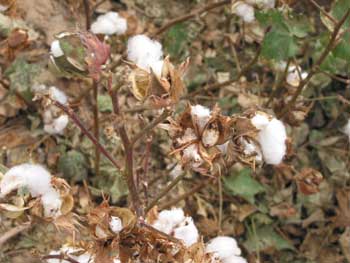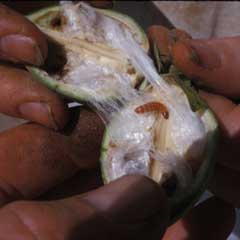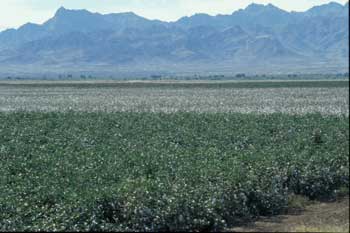Delaying Pink Bollworm Resistance
Cooperative studies and strategies protect Arizona cotton
2003
Arizona Agricultural Experiment Station Research Report
![]()
Written by
Susan McGinley
Pink bollworm (plagued Arizona cotton crops until 1996 Pectinophora gossypiella)
when Bt cotton was introduced. Containing a natural insecticide from the
bacterium Bacillus thuringiensis, the transgenic crop preserves yields
and protects farmworkers and the environment by reducing insecticide applications.
Before Bt cotton, as many as 8 to 12 sprays per season were used against
cotton pests in Arizona, but now sprays are at historic lows, with the
statewide average less than three per season. More than half of Arizona’s
cotton acreage is planted with Bt cotton. Growers adopting Bt cotton have
gained an average of $15,000 per farm each season.
This success will continue only as long as pink bollworm does not evolve resistance to Bt cotton, as it has previously to conventional insecticides. Each year tens of millions of acres of Bt cotton and Bt corn are planted worldwide—mainly in the United States and China. Yet no pest resistance to Bt crops in the field has been documented so far. Many people expected rapid pest resistance to Bt crops because the diamondback moth evolved field resistance to sprays of Bt and many pests evolved Bt resistance in the lab.
“Instead, we have evidence that pink bollworm resistance to Bt cotton
in Arizona remains rare, as does pest resistance to Bt crops worldwide,”says
Bruce Tabashnik, head of the University of Arizona’s Department of
Entomology. For the past seven years a multi-agency collaboration among
university scientists, commercial cotton growers and government agency
personnel in Arizona has focused on research and education to delay or
prevent the evolution of resistance to Bt cotton in the pink bollworm.
Major collaborators in the Bt cotton program include the Arizona Cotton
Growers Association, the Arizona Cotton Research and Protection Council,
Cotton Incorporated, and the USDA-ARS Western Cotton Research Laboratory.
In the UA College of Agriculture and Life Sciences, Tabashnik, Yves Carrière, Tim Dennehy and other researchers are studying the interaction between Bt cotton and insects. Their research is determining the effectiveness of Bt cotton, characterizing the genetic basis for pink bollworm’s potential resistance, investigating factors that affect resistance evolution, and assessing the impact of Bt cotton on non-target organisms.
 |
 |
|
Pink bollworm damage on non-Bt
cotton in Parker, Arizona
|
Close-up of cotton boll infected
with pink bollworm
|
The program includes yearly monitoring of resistance and Bt performance
in all of Arizona’s cotton growing regions, coupled with a comprehensive
grower education program conducted through Cooperative Extension. Crop
monitoring, planting of non-Bt cotton refuges, timing of planting and
other measures are part of the scheme.
“Arizona is a model for studying insect responses to genetically
engineered crops. Because transgenic crops are so controversial, the whole
world is watching to see what happens here,” Tabashnik says. “We’re
helping to provide some pieces of the puzzle.”
The Arizona team conducted a 10-year analysis in 15 cotton-growing regions
statewide that showed Bt cotton suppressed pink bollworm independent of
weather and variation among regions. Pink bollworm populations declined
significantly in regions where Bt cotton was abundant. In addition, field
data collected by the Arizona Cotton Research and Protection Council showed
that excellent performance of Bt cotton continued throughout Arizona in
the 2002 season.
A key factor delaying pink bollworm resistance has been the systematic planting of non-Bt cotton refuges near or in Bt cotton fields. Pests that would die eating transgenic cotton can survive on the non-transgenic refuge plants. Ideally, rare resistant moths that emerge from Bt cotton mate with more common susceptible moths from non-Bt cotton refuges. Studies with lab-selected resistant strains show that the hybrid offspring produced by such matings are killed by Bt cotton. Thus, in theory, the refuge strategy should greatly slow resistance.
"We’re using global positioning systems (GPS), geographic information systems (GIS) tools, and innovative statistics to test the refuge strategy,” Carrière says. He and his team members are working with grower collaborators in every cotton producing region of the state to map all Bt and non-Bt cotton fields, and to track bollworm population density.
“We found that if you plant more than a certain amount of Bt cotton in a region, the pink bollworm population starts to decline,” Carrière says. “This strongly suggests that you can transform a region that has high infestations to one that has low infestations.” The information also makes it possible to track compliance with EPA regulations for growing refuges.
“This lets us know if our extension efforts are effective,” Tabashnik says.
Along with field studies, Tabashnik, Dennehy and Carrière are conducting laboratory and greenhouse investigations to find out exactly how pink bollworms become resistant. They have found strains of pink bollworm that survive on artificial diets containing high doses of the Bt toxin and on Bt cotton. DNA analyses have revealed mutations in a gene encoding a cell adhesion protein (called cadherin) that confer resistance to Bt toxin. These mutations remain rare in pink bollworm in cotton fields, but identifying them assists prevention efforts.
“By screening pink bollworm DNA for mutations that confer resistance
to Bt cotton, we have the potential to develop monitoring tools that are
up to 5,000 times more sensitive than traditional methods,” Tabashnik
says. He observes that in most cases, the inheritance of resistance to
Bt rops is recessive, meaning that the insect would survive after eating Bt cotton
only if it received the resistant gene from both of its parents. And the
resistant genes carry a cost. Compared to ordinary bollworms, the resistant
individuals actually are less fit in the absence of Bt cotton. They have
lower survival when feeding on non-Bt cotton and during the overwintering
period.
The effective collaboration among Arizona scientists has attracted national
and international notice. Scientists and regulators from the EPA, Africa,
South America and Europe have consulted with UA scientists to help decide
how to best use Bt crops.
“We’re managing Bt cotton, but a lot of research we’re
doing is useful to other organizations,” Carrière says. In
fact, research data presented by UA entomologists have been used by the
EPA to change its guidelines for the use of Bt cotton in Arizona.
“There has been an unprecedented integrated pest management and
education effort to sustain this technology,” Dennehy says. “We
have cutting-edge genetics and ecology that fit hand-in-glove with the
growers’ needs and inputs. Half of what we do would not get done
without our interaction with growers; similarly critical has been the
leadership provided by the UA Cotton IPM Team leader, Peter Ellsworth.”
Down the line, Tabashnik, Carrière and Dennehy would like to be
able to predict the evolution of resistance, as well as regional and temporal
variation in pink bollworm population densities. This has not been done
before, but it would show if the refuge strategy worked on a large scale.
Coupled with this, Dennehy suggests a proactive resistance management
strategy that would use the DNA-based resistance detection statewide.
“Our multi-agency collaboration has the potential to deliver the world’s first highly sensitive method of detecting pest resistance to a Bt crop,” he says. “Our results show that Bt continues to be astoundingly effective in suppressing the most serious pest of cotton in the Southwest. This is the greatest technological change in entomology since the advent of conventional insecticides after World War II.”

Cotton field west of Phoenix is planted with Bt cotton in the foreground. Non-Bt cotton refuge in the background shows ravages of pink bollworm.
THE EXTENSION ARTHROPOD RESISTANCE MANAGEMENT LABORATORY (EARML)
Now in its ninth year, this laboratory serves as a central Cooperative Extension facility devoted to long-term development and maintenance of insect resistance management programs. It was established with support from the University of Arizona, and with funding from the USDA-ARS Western Cotton Research Laboratory, Cotton Incorporated, and the Arizona Cotton Growers Association.
To prevent insects from building up resistance to both natural and chemical pesticides, the laboratory conducts extensive collaborative field research and a comprehensive insect monitoring program. EARML’s mission is to collect, validate and disseminate information that will allow agricultural and urban pest managers in Arizona to combat the development of resistance to pesticides in arthropods.
For more information about EARML, contact Tim Dennehy at tdennehy@ag.arizona.edu.
CONTACT:
Yves Carrière
(520) 626-8329
ycarrier@ag.arizona.edu
Tim Dennehy
(520) 621-7124
tdennehy@ag.arizona.edu
Bruce Tabashnik
(520) 621-1151
brucet@ag.arizona.edu
Return to the Title Page
Return to the Table of Contacts
The University of Arizona is an Equal Opportunity/Affirmative
Action Employer. Any products, services, or organizations that are mentioned,
shown, or indirectly implied in this publication do not imply endorsement
by the University of Arizona.
Published January 2004
Return to College publication list